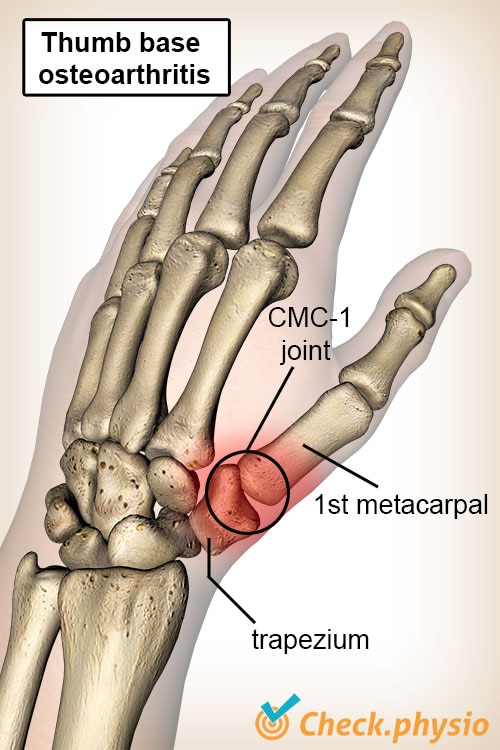Base of thumb arthritis
CMC-1 osteoarthritis / thumb base wear and tear
Base of thumb arthritis involves a problem with the joint of the thumb adjacent to the wrist. The joint is covered with a thin layer of cartilage. Base of thumb arthritis reduces the quality and density of the cartilage. As a result, daily activities may be more difficult and painful to perform.

In the past, base of thumb arthritis was also called "housewife's thumb". This was due to the fact that the disorder was more common in women who did a lot of household chores requiring a lot of squeezing and wringing. This does not mean that other people cannot suffer from base of thumb arthritis.
Description of condition
Base of thumb arthritis involves the joint referred to as the CMC-1 joint. This joint is located between one of the carpal bones (the os trapezium) and the first metacarpal bone (the os metacarpale 1). It is also called a saddle joint because of its unique shape that makes the thumb much more mobile than the other fingers.
The tips of the bone in the joint are coated in a smooth layer of cartilage. This normally makes sure that the bones slide smoothly over each other. In case of base of thumb arthritis, this layer of cartilage disappears over time. This may result in symptoms such as pain and stiffness.
This common type of osteoarthritis of the hand is seen more often in women. The risk of developing base of thumb arthritis increases as a person ages.
Cause and history
The fact that the thumb is subjected to frequent and relatively heavy strain on a daily basis makes it susceptible to base of thumb arthritis. The joint is also less stable due to its high degree of mobility. For stability, the joint depends on the joint capsule and the ligaments. When these structures weaken, either naturally or due to injury or excessive strain, problems arise.
When the capsule and ligaments can no longer do their job properly, the strain on the cartilage increases. This can lead to osteoarthritis or (partial) dislocation. These kinds of symptoms usually develop in people over 40 and are seen more frequently in menopausal women or people suffering from rheumatoid arthritis.
Signs & symptoms
Symptoms that occur in people with base of thumb arthritis are:
- (Nagging) pain at the base of the thumb.
- Local swelling.
- Loss of strength.-
Restriction of movement and stiffness.-
Cracking or grinding noises (crepitations).-
Difficulty squeezing, writing, wringing, opening jars, turning keys, etc.-
In more severe cases, the joint may deform and the thumb may become crooked.
Diagnosis
A doctor or (hand) physiotherapist will ask about the origin and consequences of the symptoms. This will be followed by a physical examination to look at the appearance and mobility of the thumb.
The grind test is a special test for the basal thumb joint which assesses pain and crepitations. In addition, several functional tests may be carried out to assess thumb strength and functionality. A possible x-ray confirms the diagnosis of base of thumb arthritis and also shows the severity of the osteoarthritis.
Treatment
The initial advice for base of thumb arthritis is to put less strain on the thumb. This can be supported by medication and exercises. The latter is often done under the supervision of a (hand) physiotherapist.
In order to properly relieve the thumb joint, a splint may be used. This stabilizes the joint when exerting pressure using the thumb. If even this does not lead to sufficient improvement, a referral to a hand surgeon may be appropriate. The surgeon may propose an injection or surgery.
Surgery
For base of thumb arthritis surgery may be performed in different ways. For example, by removing the os trapezium or securing the base joint of the thumb. Deciding which method to use will depend on personal circumstances, the severity of the osteoarthritis and the extent to which the thumb needs to be used again after surgery.
Exercises
Follow the specially compiled exercise programme with exercises for Base of thumb arthritis here.
You can check your symptoms using the online physiotherapy check or make an appointment with a physiotherapy practice in your locality.
References
Greving, J., Kok-Pigge, A., Kuijpers, T., Krastman, P., Peters-Veluthamaningal, C., de Vries, A., Wolters, R. (2021). NHG-Standaard. Hand- en polsklachten. Nederlands Huisartsen Genootschap. Versie 3.0, februari 2021.


